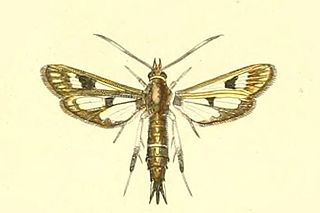
Limonium is a genus of about 600 flowering plant species. Members are also known as sea-lavender, statice, caspia or marsh-rosemary. Despite their common names, species are not related to the lavenders or to rosemary. They are instead in Plumbaginaceae, the plumbago or leadwort family. The generic name is from the Latin līmōnion, used by Pliny for a wild plant and is ultimately derived from the Ancient Greek leimon.
Bembecia priesneri is a moth of the family Sesiidae. It is found in Turkey and some nearby Dodecanese islands.
Bembecia sanguinolenta is a moth of the family Sesiidae. It is found from Bulgaria and Greece to Asia Minor, Armenia, Syria and Turkmenistan.

Microsphecia brosiformis is a moth of the family Sesiidae. It is found from the Balkan Peninsula to the Crimea, southern Russia (Sarepta), Asia Minor, the Caucasus, Iran, Turkmenistan and Afghanistan.
Negotinthia myrmosaeformis is a moth of the family Sesiidae. It is found in the countries around the Black Sea, including Ukraine, southern Russia, Romania, Bulgaria and the southern part of the Balkan Peninsula. It has also been recorded from Asia Minor, northern Iraq, Armenia and Azerbaijan.
Paranthrene diaphana is a moth of the family Sesiidae. It is found in Croatia, Bosnia and Herzegovina, Serbia and Montenegro, the Republic of Macedonia and Bulgaria, as well as Turkey, Azerbaijan and Iran.
Bembecia stiziformis is a moth of the family Sesiidae. It is found on Cyprus and from Turkey to Iran, Turkmenistan and Pakistan.

Bembecia scopigera, the six-belted clearwing, is a moth of the family Sesiidae. It is found from central Spain over most of south-western and central Europe, the Balkans, Greece, southern Russia and Ukraine to Turkey.

Pyropteron triannuliformis is a moth of the family Sesiidae. It is found from most of Europe to the Near East and Central Asia.
Dipchasphecia sertavula is a moth of the family Sesiidae. It is found only in the Sertavul Pass in southern Turkey.
Chamaesphecia turbida is a moth of the family Sesiidae. It is found in eastern Turkey, Iran and the Caucasus.
Chamaesphecia elampiformis is a moth of the family Sesiidae. It is found in Turkey and Transcaucasia.
Chamaesphecia doryceraeformis is a moth of the family Sesiidae. It is found in Turkey, Iran and Transcaucasia.
Chamaesphecia anatolica is a moth of the family Sesiidae. It is found in Turkey, Greece, Serbia and Montenegro, Romania and Hungary.
Chamaesphecia diabarensis is a moth of the family Sesiidae. It is found in north-eastern Turkey, Azerbaijan and Armenia.
Chamaesphecia schwingenschussi is a moth of the family Sesiidae. It is found in Turkey, Transcaucasia and Iran.
Chamaesphecia gorbunovi is a moth of the family Sesiidae. It is found in Greece, Turkey, Azerbaijan and Armenia.
Chamaesphecia ruficoronata is a moth of the family Sesiidae. It is found in eastern Turkey.
Pyropteron koschwitzi is a moth of the family Sesiidae. It is found in Spain and Portugal.

Pyropteron umbrifera is a moth of the family Sesiidae. It is found in Greece.



